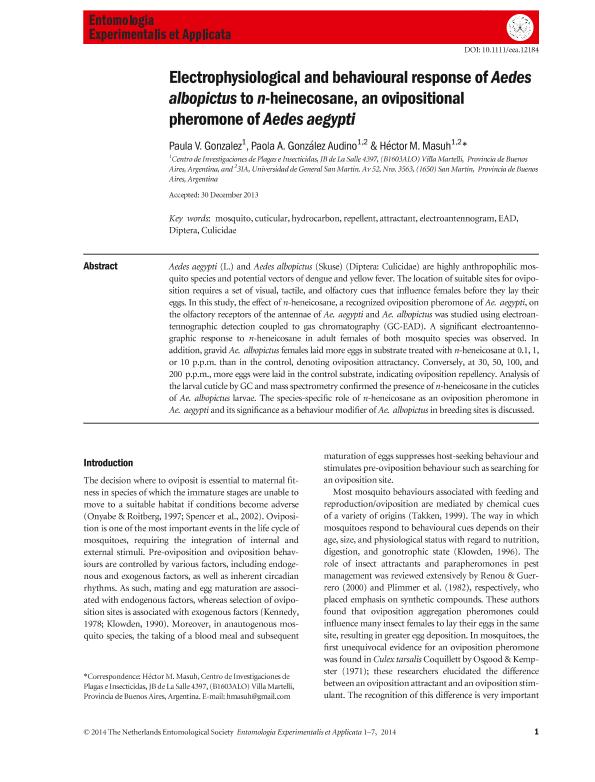Artículo
Electrophysiological and behavioural response of Aedes albopictus to n-heinecosane, an ovipositional pheromone of Aedes aegypti
Fecha de publicación:
03/2014
Editorial:
Wiley Blackwell Publishing, Inc
Revista:
Entomologia Experimentalis et Applicata
ISSN:
0013-8703
Idioma:
Inglés
Tipo de recurso:
Artículo publicado
Clasificación temática:
Resumen
Aedes aegypti (L.) and Aedes albopictus (Skuse) (Diptera: Culicidae) are highly anthropophilic mosquito species and potential vectors of dengue and yellow fever. The location of suitable sites for oviposition requires a set of visual, tactile, and olfactory cues that influence females before they lay their eggs. In this study, the effect of n-heneicosane, a recognized oviposition pheromone of Ae. aegypti, on the olfactory receptors of the antennae of Ae. aegypti and Ae. albopictus was studied using electroantennographic detection coupled to gas chromatography (GC-EAD). A significant electroantennographic response to n-heneicosane in adult females of both mosquito species was observed. In addition, gravid Ae. albopictus females laid more eggs in substrate treated with n-heneicosane at 0.1, 1, or 10 p.p.m. than in the control, denoting oviposition attractancy. Conversely, at 30, 50, 100, and 200 p.p.m., more eggs were laid in the control substrate, indicating oviposition repellency. Analysis of the larval cuticle by GC and mass spectrometry confirmed the presence of n-heneicosane in the cuticles of Ae. albopictus larvae. The species-specific role of n-heneicosane as an oviposition pheromone in Ae. aegypti and its significance as a behaviour modifier of Ae. albopictus in breeding sites is discussed. Entomologia Experimentalis et Applicata.
Archivos asociados
Licencia
Identificadores
Colecciones
Articulos(UNIDEF)
Articulos de UNIDAD DE INVESTIGACION Y DESARROLLO ESTRATEGICOS PARA LA DEFENSA
Articulos de UNIDAD DE INVESTIGACION Y DESARROLLO ESTRATEGICOS PARA LA DEFENSA
Citación
Gonzalez, Paula Valeria; Gonzalez Audino, Paola Andrea; Masuh, Hector Mario; Electrophysiological and behavioural response of Aedes albopictus to n-heinecosane, an ovipositional pheromone of Aedes aegypti; Wiley Blackwell Publishing, Inc; Entomologia Experimentalis et Applicata; 151; 3; 3-2014; 191-197
Compartir
Altmétricas




